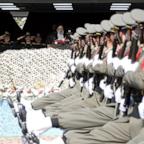Photos Worth a Thousand Words of Evidence?
June 1, 2005 — -- Brian Steidle went to Darfur armed only with a notebook and a camera.
"I heard rumors of bad things happening, genocide happening, but I had no idea what I was going to see," Steidle said.
A former United States Marine, Steidle was hired by the African Union to help document what is happening in Sudan's western region torn by violence, poverty and disease. The African Union is an international organization founded as the Organization of African Unity to promote cooperation among the independent nations of Africa.
Since the beginning of the conflict two years ago in this arid northern African country, more than 180,000 people have died and 2 million have fled their homes.
Sudan's government and the pro-government Arab militias, known as the janjaweed, are accused of killing, looting and driving out the region's black African population in response to an anti-government rebellion. Military regimes favoring Islamic-oriented governments have dominated national politics since the country's independence from Britain in 1956 and Sudan has been embroiled in a civil war ever since.
Steidle says he'll never forget the first picture he took.
When he showed up in Darfur he asked to see some wounded. "I didn't expect to see a 1-year-old girl who had been shot," he said.Steidle goes on to say, "The mother had her child wrapped on her side in cloth and was running away from the government when her child was shot in the back."
In his six months in Sudan, Steidle took over 700 pictures, many of which were villages being destroyed.
"You're sitting there watching somebody's livelihood, everything they know, be burned down in front of you and there is nothing you can do except to take photographs and write a report," he said.
His photographs, along with thousands of pages of witness interviews, are now with the International Criminal Court -- evidence for the prosecution of war crimes.
"Brian's pictures and the larger African Union evidence will be instrumental I think in getting some indictments very rapidly," said John Prendergast from the International Crisis Group, a non-profit organization that works to end violent conflicts around the world.
One example is a brutal attack on a town called Labado in December.
"The helicopter gunships, the Mi-26 Hind gunships, were making runs on the village," said Steidle. "There were no military targets down there, they were shooting the village either to start fires to burn the village or to kill civilians or anything that moved on the ground."
Steidle said the helicopter in a photo he took of the incident is a Sudanese government helicopter.
When faced with such evidence, the Sudanese government, time and time again, denies anything ever happened.
Interior Minister Abdul Rahim Muhammad Hussein flip-flops with his answers about civilians being killed and finally says, "if you said during the conflict between the people that some innocent people they died, between the two people, between the two groups fighting, that may happen definitely."




